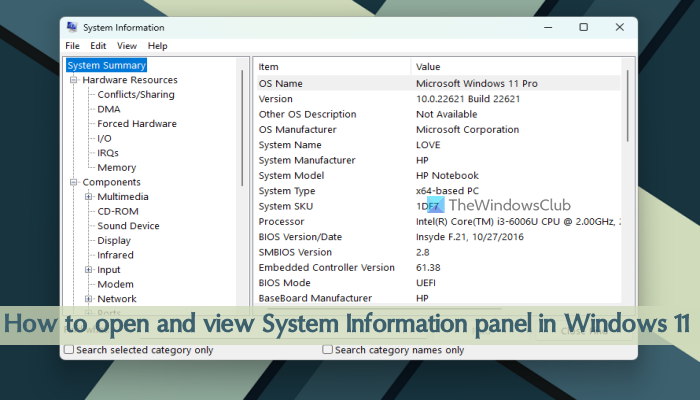Once the System Information panel is opened, you can expand different categories and check all the available information that will help you diagnose system issues. You can also export all the details as a TXT file, save details as an NFO file (System Information File) or take a print of it to generate a system report using the File menu present on its interface.
How to open and view the System Information panel in Windows 11/10
To open and view the System Information panel in Windows 11/10, you can use any of the following ways: Let’s check all these options.
1] Open Microsoft System Information Tool using Windows Search box
The quickest way to open the Microsoft System Information tool is by using the Windows 11 Search box. You can type msinfo or system information and press the Enter key and it will open the panel. You can also open the elevated System Information panel by clicking on the Run as administrator option displayed in the search results on the right section. If you won’t run the MSINFO32 tool with administrative privileges, then it may show some drivers as stopped (even if they are running). So, this is the benefit of running this System Information tool with admin rights.
2] Run MSINFO32 Tool using Windows Terminal app
Windows Terminal app also lets you run MSINFO32 Tool with or without administrative privileges using Command Prompt or PowerShell. Here are the steps: This will launch the System Information panel. You can also execute another command to export all the details as a TXT file. It will take some time to prepare and refresh the system information and then the command will be completed. The command is: In the above command, replace Desktop with some other location or path where you want to save the report and TEST with some other file name for the output file. TIP: you can also open an elevated Command Prompt window or PowerShell window separately to open the System Information panel using the same command without using Windows Terminal app.
3] Open the System Information panel using Cortana
To use the Cortana app in Windows 11 to open and view the System Information panel, follow these steps: It will launch the tool immediately. It will also provide a System Information option on its interface that you can click to open the tool.
4] Open the System Information panel using the System32 folder
System32 folder stores the application file of the Microsoft System Information tool. Access the C:\Windows\System32 folder on your Windows 11 computer. Scroll down or search for the msinfo32.exe application and execute it. To launch the tool with admin rights, right-click on msinfo32.exe and use the Run as administrator option.
5] Use the Run Command box to launch the System Information panel
Press the Win+R hotkey to open the Run Command box. Type msinfo32 in the text field and hit the Enter key.
6] Use File Explorer to open the System Information panel
Open File Explorer using Win+E hotkey on your Windows 11 PC. Type msinfo32 in the address bar of File Explorer and press Enter.
7] Open Microsoft System Information Tool using the Start menu
The steps are as follows:
8] Open and view the System Information panel using the Task Manager
Use the following steps to launch the System Information panel using the task manager:
9] Create a desktop shortcut to open the System Information panel
If you need to access the System Information tool regularly, then creating its desktop shortcut will be helpful. The steps are: That’s all! Hope this helps.
How do I open the side panel in Windows 11?
The side panel or Windows Sidebar was present in Windows Vista and Windows 7, but this feature was discontinued. So, it is not available in Windows 11. Instead, there is a Widgets feature that you can open by clicking on its icon present in the bottom left corner. If you want, you can use the best free Widgets and Gadgets for Windows 11 to add a clock widget, calculator, CPU Meter, etc.
How do I get the Classic Start menu in Windows 11?
To get back the old classic Start menu in Windows 11 or Windows 10, you can use an open-source tool called Open-Shell. In addition to that, if you want to replace Windows 11 Start menu with some other style or scheme, then there are some best free Start menu alternatives (Start Everywhere, Start Menu X, etc.) that you can use. Read next: 5 System Information Tools in Windows 11/10.

